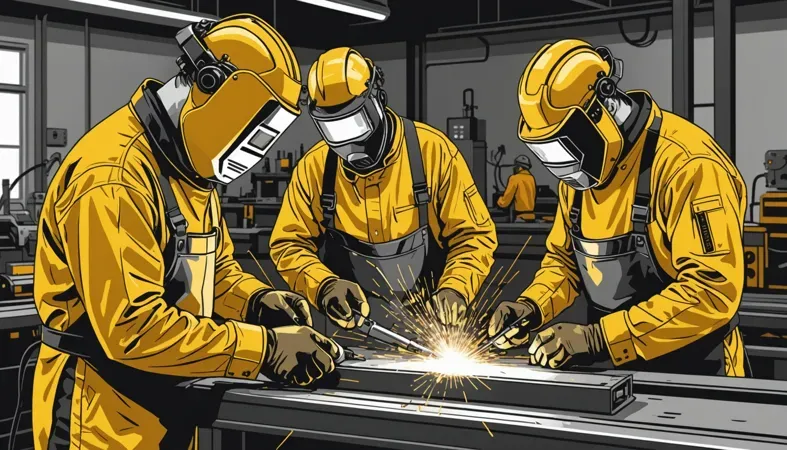How Much Does a Welder Charge? Costs, Types, and Factors Explained
Published on: January 23, 2025 | Last modified: March 4, 2025
By: Joe Carter
A welder is someone who joins materials together using heat and pressure. They play a vital role in construction, manufacturing, and repair industries.
I’ve received numerous inquiries about how much does a welder charge. It’s crucial to understand these costs because they can vary widely based on several factors. From my personal experience, knowing what to expect can help you budget better for your projects.
In this guide, you’ll find insights about types of welders and their earnings, prerequisites for becoming a welder, steps to start welding, safety tips, types of charges welders apply, and factors influencing welder costs. Also, we’ll explore how much it costs to become a welder and why it’s worth the investment.
Contents
- How Much Does A Welder Charge?
- What is a Welder?
- Types Of Welders and Their Earnings
- Prerequisites: What Do You Need?
- Safety Tips
- Steps to Become a Welder
- Types Of Charges Welders Apply
- Factors Influencing Welder Charges
- Regional Pricing Trends for Welders
- How to Address Common Problems
- Why This is Worth It: Advantages
- Applications Of Welding Services
- When to Try a Different Approach
- Frequently Asked Questions (FAQs)
- Conclusion
- References
How Much Does A Welder Charge?
A welder is a specialist who joins metal parts. So, how much does a welder charge? Rates vary from $15 to $150 per hour, depending on skill, location, and job complexity. Difficulty levels range from easy repairs to extensive fabrication. Mastering techniques like safely removing defective welds is essential, and you can explore methods for cutting welds to enhance your skills.
What is a Welder?
A welder is a skilled tradesperson who joins materials, usually metals, using high heat. They employ various techniques like MIG (Metal Inert Gas), TIG (Tungsten Inert Gas), and Stick welding to fuse materials. In the U.
S., there were about 400,000 welders as of 2022, and they’re essential in industries like construction and manufacturing. This job requires skills ranging from blueprint reading to operating heavy machinery.
Now, let’s discuss how much a welder charges. Based on my experience, rates can vary widely depending on skill level and location. For example, a welder might charge between $15 and $100 per hour, with mobile welders typically on the higher end due to travel costs.
I hired a certified welder to help me with some metal frames. Hiring a certified welder is crucial to meet construction codes, which can affect costs. It’s important to know the cost of becoming a certified welder since these professionals generally command higher rates due to their specialized training and expertise.
Types Of Welders and Their Earnings
What types of welders are there and how much do they earn?
MIG Welders
MIG welders use a wire that melts during operation. They typically charge $20 to $40 per hour. To estimate a job’s cost, check the length of weld needed—many charge per foot or hour based on the project.
TIG Welders
TIG welding requires more skill, using a non-consumable tungsten electrode. Rates for these welders range from $25 to $60 per hour. To gauge costs, consider the materials used; special metals raise the price.
Stick Welders
Stick welders use an electric arc to melt stick electrodes. They usually charge $15 to $30 per hour. To estimate costs, ask how long the job will take and the materials they’ll use, as thicker materials require more time.
Flux-cored Welders
This type uses a hollow wire filled with flux to protect the weld. Rates vary from $20 to $50 per hour. To understand charges, note that outdoor work may take longer due to wind, increasing costs.
Submerged Arc Welders
Submerged arc welding covers the arc with a layer of powder. Welders in this field can earn $30 to $70 per hour. To determine pricing, analyze the project’s scale; larger projects generally lead to better rates.
We have now covered different types of welders and their earnings. The next section discusses the necessary prerequisites for welding.
Prerequisites: What Do You Need?
What do you need to find out how much a welder charges?
- Welding Cost Calculator: Use a calculator like the Welding Cost Calculator from WeldGuru. It estimates costs based on materials and time, which is crucial for budgeting.
- Rate Guide: A resource like HomeAdvisor’s Welding Pricing Guide is essential. It provides hourly rates and project estimates to guide your decisions.
- Material Cost List: Make a list of items like steel ($0.80/kg Or $1.80/lb) and aluminum ($2.50/kg Or $1.14/lb). Knowing these is important for accurate total costs.
- Market Research: Check local welding services to compare prices. Understanding local rates helps you gauge competitive costs.
We have now covered the necessary prerequisites for this project. Next, we will discuss essential safety tips.
Safety Tips
Here are essential precautions for understanding how much a welder charges.
- Use PPE: Always wear personal protective equipment like goggles and gloves, such as Landau Disposable Gloves. They protect against burns and injuries.
- Ventilate: Ensure good airflow in workspaces with exhaust fans or vents, like the AC Infinity AIRTITAN. It helps prevent harmful fume buildup.
- Power Down: Before cleaning or adjusting machines, disconnect the power. This avoids accidental electrical shock.
- Fire Safety: Keep a fire extinguisher nearby, like the First Alert BC40, for quick response to fire risks. This protects you and your workspace.
Remember, safety isn’t just a precaution; it’s a priority I’ve learned firsthand.
We covered safety practices for welding. We will now cover the essential steps to become a welder.
Steps to Become a Welder
Now, we’ll cover the steps to determine how much a welder charges.
Research Welding Rates in Your Area
Start by checking local rates for welders. In the U.
S., the average hourly rate is around $20 to $60 (Approx. €18 to €54). Rates fluctuate based on skill level, type of welding, and demand. Use local job boards or trade websites to gather this data. For those concerned about safety, understanding welding burns on skin is crucial.
Consider different sectors like construction or manufacturing, where prices can vary significantly. For instance, specialized welders charge more than general welders. Use this research to establish a baseline for your client charges.
Identify Your Specialty Area
Specializing in a specific type of welding allows you to charge more. For example, underwater welding can earn over $100 (Approx. €90) per hour due to its complexity and risk. Consider areas like MIG, TIG, or stick welding to find your niche.
Knowing your specialty helps you set charges based on market demand. Take courses related to your field to enhance your skills. I found that courses in copper and aluminum welding significantly improved my earning potential.
Factor in Your Experience
Your experience level directly affects your rate. A beginner might charge around $15 to $25 (Approx. €14 to €23), while an expert can expect $50 to $100 (Approx. €46 to €90) per hour. This experience should reflect in your pricing, as clients value expertise.
Communicate clearly with clients, demonstrating your growth and accomplishments over time. Showcase certifications or a portfolio of your work. I’ve seen that displaying years of service builds customer trust and influences how much they’re willing to pay.
Calculate Your Business Expenses
Examine your operating costs, including tools, materials, transport, and insurance. Ensure your earnings cover these expenses and leave a profit. A good rule of thumb is to charge 1.5 to 3 times your costs, depending on the service.
Account for unforeseen expenses by building a financial buffer into your rates, especially as a self-employed welder. I learned to calculate my costs carefully, which helped me create competitive pricing while maintaining a good income.
Keep Track Of Market Trends
Stay informed about market changes. Trends like sustainable welding or automated processes can shift demand and wages. Follow industry publications and participate in local welding events to stay relevant. Consider a monthly check-in to compare your rates.
Adapting to these trends keeps you competitive. Adjusting your offerings based on market needs may increase your income. I’ve found networking with peers helps me stay updated on industry changes.
That covers the stages involved in becoming a welder. Let’s now take a look at the different welding charges used.
Types Of Charges Welders Apply
Let’s explore the different charges welders apply, including hourly rates, project rates, material costs, travel expenses, and equipment rental fees.
Hourly Rates
Welders typically charge by the hour, ranging from $20 to $100. Factors affecting this rate include experience, location, and job complexity. For example, advanced certification or specialized welding techniques can lead to higher pay.
Project Rates
Some welders prefer flat rates for jobs, usually between $500 and $5,000, depending on project size and scope. For instance, simple repairs might cost less, while extensive fabrication demands a higher price. When it comes to modifying or correcting previous work, understanding how to remove welds is crucial for achieving precision.
Material Costs
Don’t overlook materials! Costs can range from $50 to $1,500 for supplies like metal, rods, or filler material. I remind clients to budget for this, as it can significantly impact the overall cost.
Travel Expenses
Travel fees vary by distance. If a welder drives over 50 miles (80 Kilometers), they may charge extra, adding $0.50 to $2.00 per mile.
Equipment Rental Fees
Welders may need extra equipment. Rental fees can range from $100 to $1,000 per day, depending on what’s required. In my experience, it’s crucial to include this in project cost estimates to avoid surprises.
Factors Influencing Welder Charges
What factors affect the fees a welder may charge for their services?
Experience Level
A seasoned welder typically charges more. For example, entry-level welders might bill around $15-$20 per hour, while highly skilled professionals can command $35-$100 per hour.
Type Of Welding Service
Different welding techniques have varying costs. For instance, TIG (Tungsten Inert Gas) welding is generally pricier due to its precision, costing around $90-$150 per hour, compared to MIG (Metal Inert Gas) welding’s $50-$75 per hour.
Market Demand
When demand increases, so do prices. I recommend checking local ads and making calls. During busy seasons, rates can rise by 20-50% due to high competition for skilled welders.
Geographical Location
Your location heavily influences welder fees. Urban areas usually see higher rates, often ranging from $60-$120 per hour, while rural areas average $40-$70.
Project Complexity
The harder the job, the higher the cost. Simple jobs might cost around $200, while intricate projects can run $1,500 or more, depending on materials and time needed.
Regional Pricing Trends for Welders
To understand how much a welder charges, it’s essential to know regional pricing trends.
| Region | Average Hourly Rate (USD) | Key Factors Affecting Rates |
|---|---|---|
| West Coast | $75-$150 | High demand, cost of living, specialized services |
| Midwest | $50-$100 | Stable demand, lower cost of living |
| South | $40-$90 | Varied demand, competition among welders |
| Northeast | $60-$120 | High demand, skilled labor requirements, strict regulations |
- Local Economy: An area’s economic status influences rates. In bustling metro areas, prices generally run higher due to demand.
- Cultural Factors: Some regions have a tradition of high craftsmanship, raising the price for skilled welding.
- Transport Costs: If a welder needs to travel to a job site, they might add travel expenses, impacting overall costs.

How to Address Common Problems
Let’s look at some issues welders often face and how to tackle them effectively.
Miscommunication With Clients
Misunderstandings with clients happen often. Keep clear records of all communications. Verify details in writing. Resolve issues by asking clarifying questions and setting expectations upfront.
Unexpected Material Costs
Material prices can rise unexpectedly. I recommend tracking market rates regularly and discussing budgets with clients before starting. Be upfront about potential price fluctuations to manage expectations.
Equipment Failures
Equipment can fail at crucial moments. Regular maintenance is essential. Identify faulty gear through consistent testing and inspecting connectors and cables. Keep spare parts on hand and schedule routine checks.
Time Delays
Project timelines can slip for various reasons. Use project management tools to spot delays. Resolve issues by identifying bottlenecks early and communicating proactively with stakeholders.
Quality Issues
Welding quality can sometimes suffer. Conduct visual inspections and test weld strength. Address problems by following standard welding procedures and regularly seeking feedback from clients.
Why This is Worth It: Advantages
The value of hiring a skilled welder is clear. A professional welder helped me quickly and effectively fix a structural issue at work.
Moreover, investing in a good welder offers multiple benefits: quality craftsmanship, time efficiency, guaranteed safety, and the potential for long-lasting results.
Applications Of Welding Services
People use welding for various custom projects. Its primary applications include:
- Metal Fabrication: Welders create custom frames and structures for specific machinery. This is common in manufacturing because it allows tailored solutions.
- Automotive Repair: Welding is essential for fixing vehicle bodies and exhaust systems. It’s widely used for strong, durable repairs.
- Construction of Steel Buildings: Welders join beams and panels, which are crucial for erecting high-rise structures. It offers strength, stability, and safety.
- Pipelines Installation: Welders connect pipes, especially in the oil and gas industries. This application is vital for leak-proof joints and reliability.

When to Try a Different Approach
Sometimes, you might want to skip hiring a welder altogether. Alternatives like portable welders, such as the Hobart Handler 140, can do the job at home. In my professional journey, I’ve found that using a welding kit saves both time and money for small projects. It’s essential to recognize the potential health risks involved in welding activities, including the possibility of welding-related cancer hazards.
Don’t forget about DIY options! Consider renting welding equipment if your project’s a one-time deal. Brands like Miller offer rental services that cut your costs, especially if you’re unsure about how much it costs to hire a welder for larger jobs.
Frequently Asked Questions (FAQs)
Now let us look at some unique questions I typically get asked.
How Do You Quote a Welding Job?
You can quote a welding job by assessing the project’s details. First, determine labor time, materials, and additional costs like permits. Typically, the labor rate is $50 to $150 (USD) per hour, depending on the job’s complexity and location.
How Much Does It Cost to Become a Welder?
The cost to become a welder averages around $5,000 to $15,000 (USD). This includes training programs, materials, and certifications. Investing in good training can enhance skills and potentially increase earning capacity over time. A critical part of welding practice involves understanding essential safety procedures, such as how to ground a welder, to ensure both effectiveness and personal safety.
.
How Do You Calculate Welding Cost?
To calculate welding cost, consider materials, labor hours, and overhead. Use the formula: Total Cost = Material Cost + (Hourly Rate × Hours Worked) + Overhead. This method gives a solid estimate for your welding project.
How Much Welding Can Be Done in an Hour?
The amount of welding done in an hour depends on the joint’s complexity and the welder’s skill level. On average, a skilled welder can complete 10 to 20 meters (32 to 65 Feet) of weld per hour. Be mindful that intricate jobs may take longer.
How Much Does It Cost to Learn to Weld?
The cost to learn welding can range from $350 to $20,000 (USD), depending on whether you choose community college or trade schools. Some programs offer financial aid, so exploring welding career guidance options is wise.
Conclusion
We covered the types of welders and their earnings, prerequisites for becoming a welder, steps to get started, and crucial safety tips. We also discussed the types of charges welders apply, factors that influence their fees, and provided some common problem-solving tips. Don’t forget about aftercare, inspection, and the advantages of hiring a professional welder.
So, how much does a welder charge? Generally, expect rates ranging from $15 to $75 USD per hour, depending on their experience level and project complexity. For specialized work or certified welders, costs can soar up to $150 USD or more. Feel free to reach out if you have further questions about how to hire a welder or get started in welding.
For a deeper understanding of the welding profession, be sure to visit What is Welding, where you can find comprehensive information and resources.
References
- American Society of Mechanical Engineers. (2019). ASME Section IX: Welding and Brazing Qualifications. New York, NY: ASME.
- Lancaster, J. F. (1999). The Physics of Welding (2nd ed.). Oxford, UK: Pergamon Press.
Joe Carter is a retired welding professional with over 40 years of hands-on experience in the industry, spanning ship repair, structural welding, and even underwater projects. Joe is a master of MIG, TIG, and Stick welding. Passionate about mentoring the next generation of welders, Joe now shares his decades of expertise and practical insights to help others build rewarding careers in welding.
Factors Influencing Welder Fees, Personal Protective Equipment, Safety Tips, Types Of Welders, Welder Charges, Welding, Welding Costs, Welding Equipment, Welding Prerequisites, Welding Safety Tips, Welding Techniques







